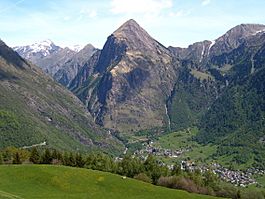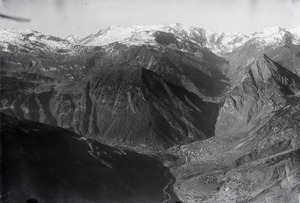Olivone facts for kids
Quick facts for kids
Olivone
|
||
|---|---|---|

Olivone at the feet of Sosto (2.221 m)
|
||
|
||
| Country | Switzerland | |
| Canton | Ticino | |
| District | Blenio | |
| Area | ||
| • Total | 76.1 km2 (29.4 sq mi) | |
| Elevation | 902 m (2,959 ft) | |
| Population | ||
| • Total | 867 | |
| • Density | 11.393/km2 (29.51/sq mi) | |
| Postal code |
6718
|
|
| Surrounded by | Acquarossa, Aquila, Calpiogna, Campello, Campo (Blenio), Faido, Ghirone, Mairengo, Medel (Lucmagn) (GR), Osco, Quinto, Vals (GR) | |
Olivone was once a small town, also called a municipality, located in the Blenio area of the canton of Ticino in Switzerland.
On January 25, 2005, the local government decided that Olivone would join with four other towns: Aquila, Campo Blenio, Ghirone, and Torre. Together, they would form a new, larger municipality called Blenio. This change officially happened on October 22, 2006.
Contents
A Glimpse into Olivone's Past
Olivone is a very old place. It was first written about in 1193, called Alivoni. Later, in 1205, it was known as Orivono. In the Romansh language, people called it Luorscha.
Early Rulers and Revolts
In the past, a powerful family called De Torre controlled the upper Blenio valley. They owned land in Olivone. But in 1182, an agreement called the oath of Torre ended their power.
Later, in 1213, the people of Olivone and Aquila were unhappy. They joined forces and rebelled against the Da Locarno family. The Da Locarno family had been given control by church leaders from Milan. The people of Olivone and Aquila successfully drove them out. They went back to being ruled by a governor from Lombardy.
The Assembly of Free People
An important group called L'assemblea di uomini liberi (The Assembly of the Free) started around 1136. This group helped manage shared forests and mountain pastures. They also worked to keep the Lukmanier and Greina mountain passes open. These passes were important for travel and trade.
By the late 1300s, this assembly also managed a special lease. This lease was for the Santa Maria mountain pasture, which belonged to a monastery. The rules for the village were written down in 1237 and again in 1474.
Churches and Hospices
During the Early Middle Ages, Olivone was likely the main church center for the whole valley. The village's history from the High and Late Middle Ages is similar to the rest of the valley.
The main church, S. Martino, was built before 1136. It was rebuilt in the 1600s and later renovated in the 1970s and 1980s. Inside, you can see beautiful frescos (wall paintings) from the 1600s and 1700s. The church's valuable items are shown in the Cà da Rivöi. This building is from the 1400s, and Rivöi is the local word for Olivone.
Two special places called hospices were built along the Lukmanier road. A hospice was like a guesthouse for travelers. The Hospice of SS Sepolcro e Barnaba at Casaccia was built in 1104. The Hospice of S. Defendente in Camperio followed in 1254. Rich families likely started these hospices. Local people later managed them. They were very important for the community until the 1400s.
Life and Work in Olivone
For a long time, Olivone's economy relied on farming. People raised dairy cows and other livestock. However, from the 1400s to the 1800s, many people left Olivone to find work. They sent money back home from places like Italy, France, England, and other Swiss cities.
Interestingly, chocolate makers from Olivone became very famous. They had a great reputation in Italy and France starting in the 1600s.
Modern Times and Tourism
In the late 1800s, tourism started to become important for Olivone. It grew even more in the 1900s. People began to care more about protecting nature and historical sites. By the early 2000s, Olivone was known for both winter and summer tourism.
Even with tourism growing, Olivone kept its farming roots. In 1956, a power plant, Blenio Kraftwerke AG, was built there. Some construction companies also set up shop in the town. Olivone is also home to the Alpine Institute of Chemistry and Toxicology. This institute is part of the Alpine Foundation for Life Sciences. In 2005, about 22% of the jobs in Olivone were still in agriculture.
Population Over Time
Here's how the number of people living in Olivone changed over many years:
| Year | Population Olivone |
|---|---|
| 1567 | 593 |
| 1602 | 1,000 |
| 1682 | 1,018 |
| 1745 | 734 |
| 1785 | 640 |
| 1801 | 644 |
| 1850 | 758 |
| 1900 | 765 |
| 1950 | 707 |
| 1960 | 930 |
| 2000 | 845 |





